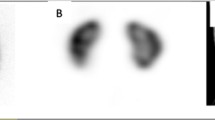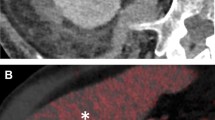Abstract
The purpose of this prospective study is to compare 3 types of99mTc-DMS A renal scan [(a) planar, (b) x-ray type film static SPECT presentation (SPECT-1) and (c) dynamic three-view display of SPECT slices (SPECT-2)], intravenous urography, and ultrasonography in the diagnosis of renal scars. All these studies were performed in 130 pediatric patients, with urinary tract infection (42 patients), vesicoureteral reflux (37), and unilateral or bilateral small kidney(s) (51). The number of renal scars detected was highest with the99mTc-DMS A renal SPECT-1 scan and next came the99mTc-DMSA renal SPECT-2 studies. There is a significant difference (p < 0.05) between the ability of planar and SPECT-1 to recognize renal defects. However, SPECT-2 may provide the best stereotactic localization and image quality of all the methods.
Similar content being viewed by others
References
Savage JM, Dillon MJ, Shah V, Barratt TM, Williams DI. Renin and blood pressure in children with renal scarring and vesicoureteral reflux.Lancet 2: 411–414, 1978.
Bernstein J, Arant BS Jr. Morphological characteristics of segmental renal scarring in vesicoureteral reflux.J Urol 148: 1712–1714, 1992.
Berg UB. Long-term followup of renal morphology and function in children with recurrent pyelonephritis.J Urol 148: 1715–1720, 1992.
Olbing H, Claesson I, Ebel KD, et al. Renal scars and parenchymal thinning in children with vesicoureteral reflux: a 5-year report of the International Reflux Study in Children (European Branch).J Urol 148: 1653–1656, 1992.
Merrick MV, Uttley WS, Wild SR. The detection of pyelonephritic scarring in children by radioisotope imaging.Br J Radiol 53: 544–546, 1980.
Shanon A, Feldman W, McDonald P, et al. Evaluation of renal scars by technetium-labeled dimercaptosuccinic acid scan, intravenous urography, and ultrasonography: A comparative study.J Pediatr 120: 399–403, 1992.
Rushton HG, Majd M, Jantausch B, Wiedermann BL, Belman AB. Renal scarring following reflux and nonreflux pyelonephritis in children: evaluation with99mtechnetium-dimercaptosuccinic acid scintigraphy.J Urol 147: 1327–1332, 1992.
Arant BS Jr. Medical management of mild and moderate vesicoureteral reflux: followup studies of infants and young children. A preliminary report of the Southwest Pediatric Nephrology Study Group.J Urol 148: 1683–1687, 1992.
Kangarloo H, Gold RH, Fine RN, Diament MJ, Boechat MI. Urinary tract infections in infants and children evaluated by ultrasound.Radiology 154: 367–373, 1985.
Dillon MJ, Gordon I, Shah V.99mTc-DMSA scarring and segmental renal vein renin estimates in children with renal scarring.Contrib Nephrol 39: 20–27, 1984.
Verber IG, Studley MR, Meller ST.99mTc-dimercaptosuccinic acid scan as the first investigation of urinary tract infections.Arch Dis Child 63: 1320–1325, 1988.
Smellie JM, Shaw PJ, Prescod NP, Bantock HM. 99mTc dimercaptosuccinic acid (DMSA) scan in patients with established radiological renal scarring.Arch Dis Child 63: 1315–1319, 1988.
Whitear P, Shaw P, Gordon I. Comparison of 99mTc dimercaptosuccinic acid scans and intravenous urography in children.Br J Radiol 63: 438–443, 1990.
Ozen HA, Basar I, Erbas B, et al. DMSA renal scanning versus urography for detecting renal scars in vesicoureteral reflux.Eur Urol 17: 47–50, 1990.
Melis K, Vandevivere J, Hoskens C, Vervaet A, Sand A, van Acker KJ. Involvement of the renal parenchyma in acute urinary tract infection: the contribution of 99mTc dimercaptosuccinic acid scan.Eur J Pediatr 151: 536–539, 1992.
Rosenberg AR, Rossleigh MA, Brydon MP, Bass SJ, Leighton DM, Farnsworth RH. Evaluation of acute urinary tract infection in children by dimercaptosuccinic acid scintigraphy: a prospective study.J Urol 148: 1746–1749, 1992.
Williams ED. Renal single photon emission tomography: should we do it?Semin Nucl Med 22: 112–121, 1992.
Mouratidis B, Ash JM, Gilday DL. Comparison of planar and SPECT99mTc-DMSA scintigraphy for the detection of renal cortical defects in children.Nucl Med Commun 14: 82–86, 1993.
Elison BS, Taylor D, van der Wall H, et al. Comparison of DMSA scintigraphy with intravenous urography for the detection of renal scarring and its correlation with vesicoureteral reflux.Br J Urol 69: 294–302, 1992.
Monsour M, Azmy AF, MacKenzy R. Renal scarring secondary to vesicoureteric reflux: critical assessment and new grading.Br J Urol 60: 320–324, 1987.
Dwoskin JY, Perlmutter AD. Vesicoureteral reflux in children: a computerized review.J Urol 109: 888–890, 1973.
Smellie J, Edwards D, Hunter N. Vesicoureteral reflux and renal scarring.Kidney Int 8: S65–72, 1979.
Alon U, Pery M, Davidi G, Berant M. Ultrasonography in radiologic evaluation of children with urinary tract infection.Pediatrics 78: 58–64, 1986.
Johnson CE, DeBaz BP, Shurin PA, DeBartolomeo R. Renal ultrasound evaluation of urinary tract infections in children.Pediatrics 78: 871–878, 1986.
Maneval DC, D’Argenio DZ, Wolf W. A kinetic model for99mTc-DMSA in the rat.Eur J Nucl Med 16: 29–34, 1990.
Taylor A, Lallone RL, Hagan PL. Optimal handling of dimercaptosuccinic acid for quantitative renal scanning.J Nucl Med 21: 1190–1193, 1980.
Goldraich NP, Alvarenga AR, Goldraich IH, Ramos OL, Sigulem D. Renal accumulation of Tc-99m DMSA in the artificially perfused isolated rat kidney.J Urol 134: 1282–1286, 1985.
Provoost AP, Van Aken M. The effect of DMSA loading on the renal handling of technetium-99m in rats.Uremia Invest 9: 147–150, 1986.
Murase K, Tanada S, Ishine M, Yokoyama M, Hamamoto K. Methods for measuring the renal uptake rate of99mTc-dimercaptosuccinic acid (DMSA): a comparative study.J Nucl Med 6: 725–731, 1990.
Groshar D, Embon OM, Frenkel A, Front D. Renal function and technetium-99m-dimercaptosuccinic acid uptake in single kidney: the value ofin vivo SPECT quantitation.J Nucl Med 32: 766–768, 1991.
Itoh K, Asano Y, Tsukamoto E, et al. Single photon emission computed tomography with99mTc-dimercaptosuccinic acid in patients with upper urinary infection and/or vesicoureteral reflux.Ann Nucl Med 5: 29–34, 1991.
Author information
Authors and Affiliations
Rights and permissions
About this article
Cite this article
Yen, T.C., Chen, W.P., Chang, S.L. et al. A comparative study of evaluating renal scars by99mTc-DMSA planar and SPECT renal scans, intravenous urography, and ultrasonography. Ann Nucl Med 8, 147–152 (1994). https://doi.org/10.1007/BF03165020
Received:
Accepted:
Issue Date:
DOI: https://doi.org/10.1007/BF03165020




